Birds of the Adirondacks:
Yellow-rumped Warbler (Setophaga coronata)
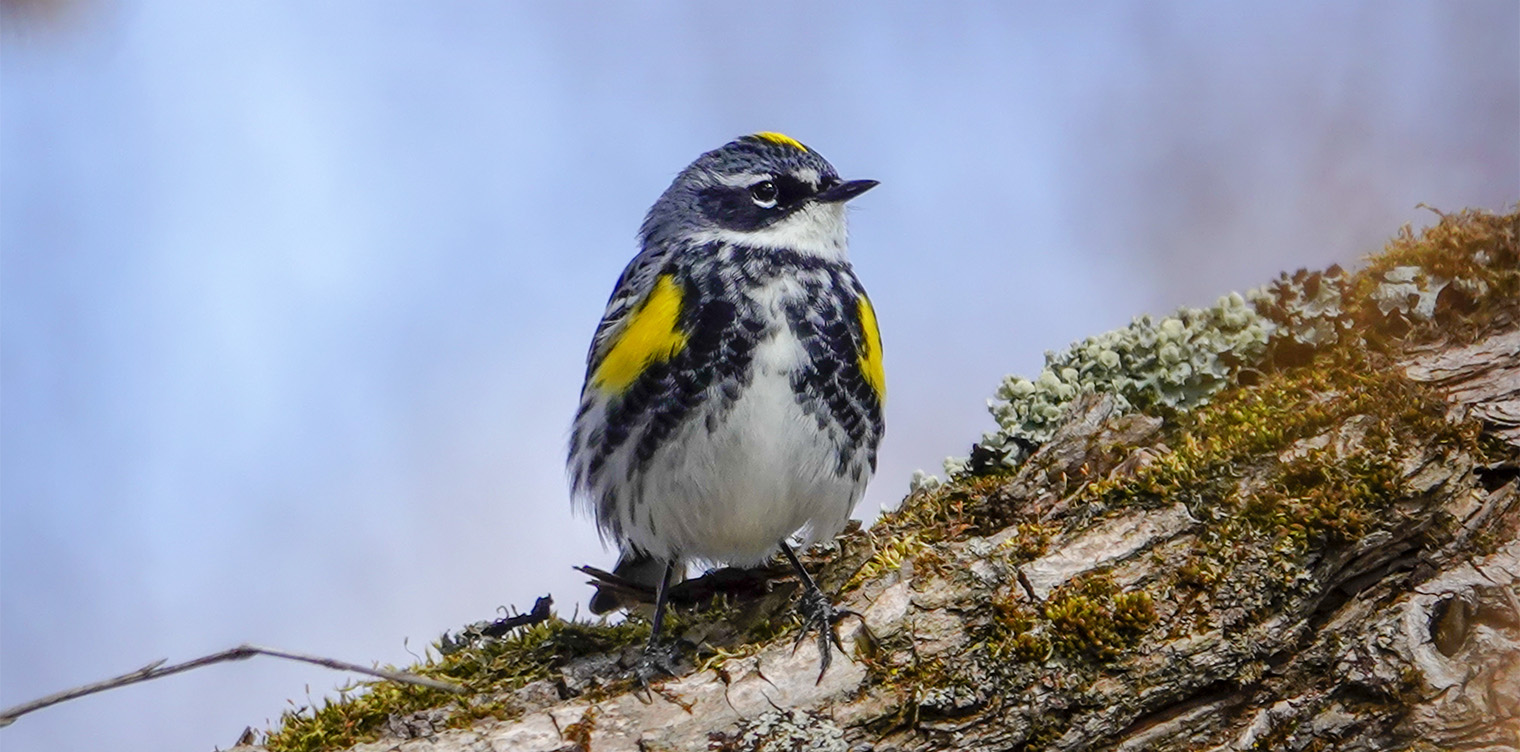
The Yellow-rumped Warbler (Setophaga coronata) is a common yellow and black warbler that breeds in mature conifer and mixed forests in the Adirondacks.
The Yellow-rumped Warbler is a member of the New World Warbler or Wood Warbler family (Parulidae). Wood warblers subsist mainly on insects during breeding season and are primarily foliage gleaners, with slender, pointed bills. There are about 119 species in the wood warbler family, currently divided into 18 genera. The Second Atlas of Breeding Birds in New York State (2008) lists 33 warbler species (plus one hybrid) that breed in New York State; 29 are listed as possible, probable, or confirmed breeding birds in the Adirondack Park. All are migratory. Most arrive in the Adirondack Mountains in late April or early May and depart in September or October.
As with many other birds, the Yellow-rumped Warbler has been recategorized several times, resulting in multiple changes in its scientific name.
- The Yellow-rumped Warbler was previously assigned to the Dendroica genus. In 2011, as part of a larger rearrangement of Wood Warbler taxonomy based on DNA studies, the Dendroica genus was merged with the Setophaga genus, which now contains at least 33 species. Older publications list the Yellow-rumped Warbler as Dendroica coronata.
- In 1973, the American Ornithologists' Union merged four species – Myrtle Warbler (eastern US), Audubon's Warbler (western US), Mexican Black-fronted Warbler, and Goldman's Warbler (Guatemala) – into one: Setophaga coronata, demoting the previous species to subspecies. This move did not please many birders and specialists, who pointed to significant differences between the subspecies.
- A proposal in 2017 to re-split the Yellow-rumped Warbler into three separate subspecies failed to pass muster with the American Ornithologists' Union, although the Integrated Taxonomic Information System lists the Yellow-rumped Warbler, Audubon's Warbler, and Goldman's Warbler as separate species.
The Yellow-rumped Warbler's current genus (Setophaga) is a large group which includes many other warblers that breed in the Adirondacks, including the Palm Warbler, Magnolia Warbler, Chestnut-sided Warbler, Cape May Warbler, Northern Parula, Blackburnian Warbler, Black-throated Blue Warbler, Black-throated Green Warbler, Pine Warbler, Blackpoll Warbler, American Redstart, and Yellow Warbler.
- The genus name Setophaga is derived from the Greek ses ("moth") and phagos ("eating").
- The species name (coronata) means "crowned" – a reference to the yellow patch on the bird's head.
- Our Yellow-rumped Warbler is the eastern (or "Myrtle") Yellow-rumped Warbler (identified in some sources as Setophaga coronata coronata).
The bird's nonscientific name – Yellow-rumped Warbler – refers to its bright yellow rump patch. Other nonscientific names include Yellow-crowned Wood Warbler, Golden-crowned Fly-catcher, Myrtle Warbler, Eastern Myrtle Warbler, Waxmyrtle, and Myrtlebird. The latter names derive from the bird's fondness for the wax myrtle. Birders also refer to this warbler by its nickname: Butterbutt.
Yellow-rumped Warbler: Identification
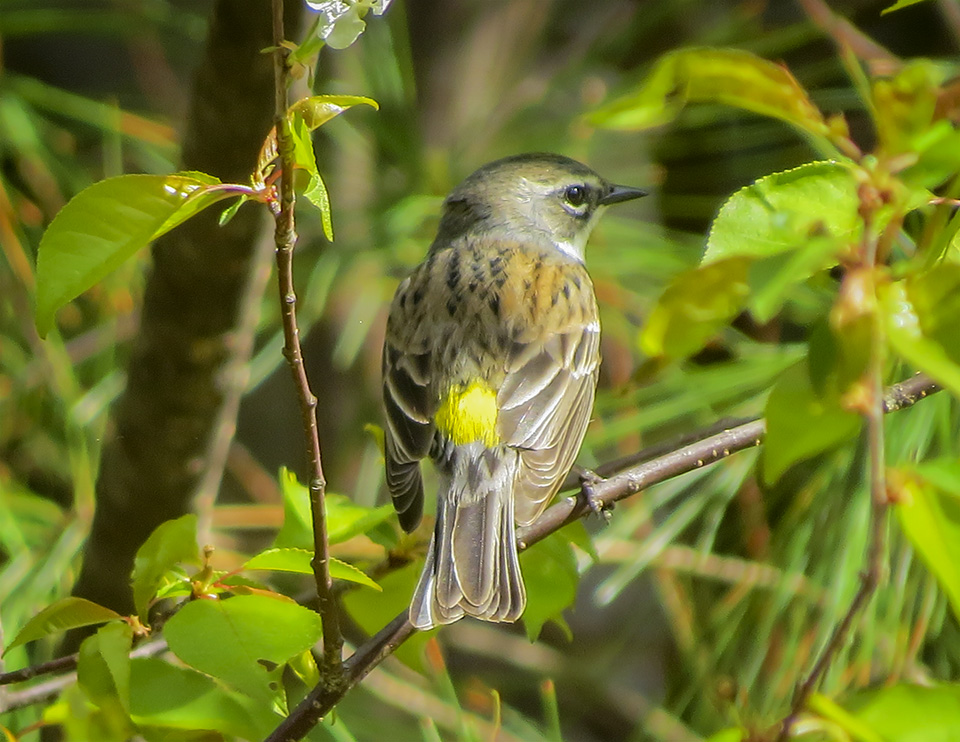
Yellow-rumped Warblers are small songbirds; they are about 5.4 inches in length from the tip of the beak to the tip of the tail, with a wing span of 8.8 inches. Their average weight is 0.46 ounces. Compared to other warblers that breed in our area, the Yellow-rumped Warbler is a little above average, larger than the tiny Northern Parula (at 4.4 inches in length and 0.31 ounces), but much smaller than the Ovenbird (at 6 inches in length and 0.71 ounces) or Louisiana Waterthrush (at 6 inches in length and 0.74 ounces).
The most distinctive feature of the Yellow-rumped Warbler in all plumages is the bright yellow patch on its rump. Other field marks include yellow shoulder patches, light-colored eye arcs, wing bars, a large tail with large white spots and black edges, and a variably streaked chest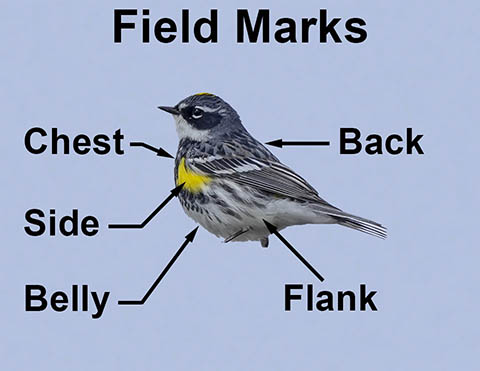 Chest: The chest (also called the breast) is the upright part of the bird’s body between the throat and the abdomen. , flanks
Chest: The chest (also called the breast) is the upright part of the bird’s body between the throat and the abdomen. , flanks Flank: The lateral area posterior to the side region, lying below the pelvis and extending back to the base of the tail., and back.
Flank: The lateral area posterior to the side region, lying below the pelvis and extending back to the base of the tail., and back.
Breeding Males: Male Yellow-rumped Warblers in breeding plumage are the easiest to identify. Look for a blue-gray and black bird with bright yellow markings on the shoulder and rump, a strip of yellow on the crown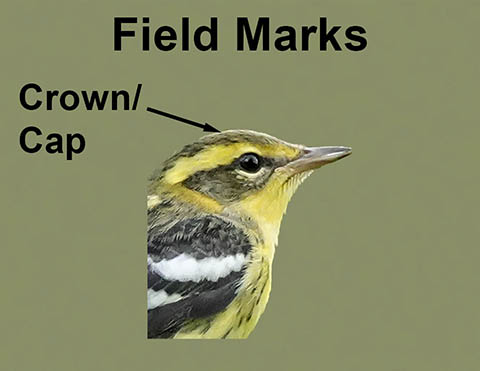 Crown/cap: The top of a bird's head. Some birds have a central crown stripe. , white wing bars, a white belly, and heavy black streaking on the chest
Crown/cap: The top of a bird's head. Some birds have a central crown stripe. , white wing bars, a white belly, and heavy black streaking on the chest Chest: The chest (also called the breast) is the upright part of the bird’s body between the throat and the abdomen. and flanks
Chest: The chest (also called the breast) is the upright part of the bird’s body between the throat and the abdomen. and flanks Flank: The lateral area posterior to the side region, lying below the pelvis and extending back to the base of the tail.. Spring male Yellow-rumped Warblers have a complicated facial pattern, with a black face patch, white crescents above and below the eye, a streak of white above the eye, and a white throat.
Fall males are duller and brownish, rather than black.
Flank: The lateral area posterior to the side region, lying below the pelvis and extending back to the base of the tail.. Spring male Yellow-rumped Warblers have a complicated facial pattern, with a black face patch, white crescents above and below the eye, a streak of white above the eye, and a white throat.
Fall males are duller and brownish, rather than black.
Breeding Females: Adult female Yellow-rumped Warblers in breeding plumage are
duller and browner than males. They have the bright yellow rump patch that helps distinguish this warbler. The yellow side patches of the female are paler than in the male. The female also has less streaking on the flanks Flank: The lateral area posterior to the side region, lying below the pelvis and extending back to the base of the tail.. In addition, the female's face mask is gray-brown rather than black. Nonbreeding females are brown on the back with dark streaks; they retain the side streaking, but it is less sharp than in the spring.
Flank: The lateral area posterior to the side region, lying below the pelvis and extending back to the base of the tail.. In addition, the female's face mask is gray-brown rather than black. Nonbreeding females are brown on the back with dark streaks; they retain the side streaking, but it is less sharp than in the spring.
Immatures: Immature Yellow-rumped Warblers resemble the female. They have more brown overall, with faint, diffuse streaking, a brown back, and only hints of yellow in the shoulder patches.
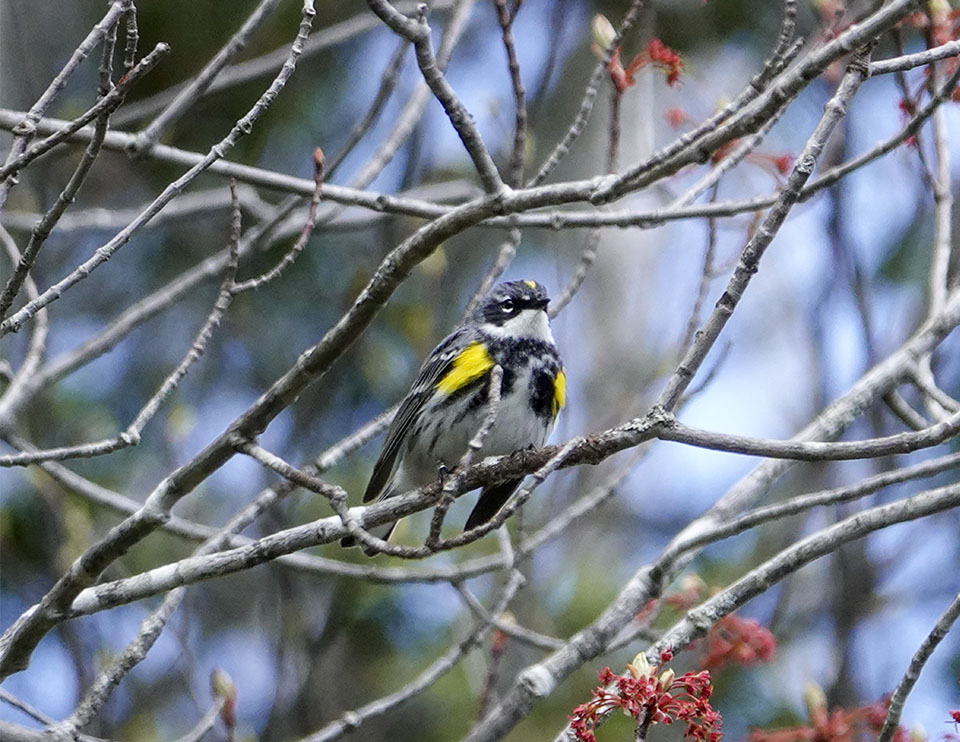
Similar Species: There are several other birds that are somewhat similar in coloring to the Yellow-rumped Warbler.
- Magnolia Warblers also have a yellow rump in all plumages. However, in contrast to the Yellow-rumped-Warbler, Magnolia Warblers in all plumages have a black and white tail which, from the underside, looks like the tip was dipped in black ink. In addition, the underparts of the Yellow-rumped Warbler are white and black, contrasting with the yellow underparts of the Magnolia. Female Magnolia Warblers and female Yellow-rumped Warblers may also be confused. Both have a yellowish patch on the rump, white wing bars, and streaks down the sides. However, the female Magnolia Warbler has a yellow belly, contrasting with the white belly of the female Yellow-rumped. The diagnostic black tail tip in the female Magnolia Warbler is another point of contrast.
- The Cape May Warbler is another warbler with a yellowish rump, and some dull Yellow-rumped Warblers may resemble immature Cape May Warblers. Both birds have white wing bars. However, the Yellow-rumped Warbler has a brighter yellow rump patch, a heavier bill, and its streaking is concentrated on the sides of the breast, while that of the Cape May's is distributed across the entire breast.
- The immature Palm Warbler has a very dull yellow rump. However, its distinctive tail bobbing helps differentiate it from the Yellow-rumped.
Yellow-rumped Warbler: Songs and Calls
Male Yellow-rumped Warblers, like some other warbler species, have several different songs. Yellow-rumped songs are quite variable and can be difficult to identify, but the most commonly heard song in our area is a flat shivering trill. Males generally begin singing during spring migration and continue to sing on their breeding grounds through late July or early August. Singing usually begins about 30 minutes before sunrise. Song frequency declines around midmorning.
The Yellow-rumped Warbler's call note is a shark "chek." Both males and females make this call frequently while foraging.
Yellow-rumped Warbler: Behavior
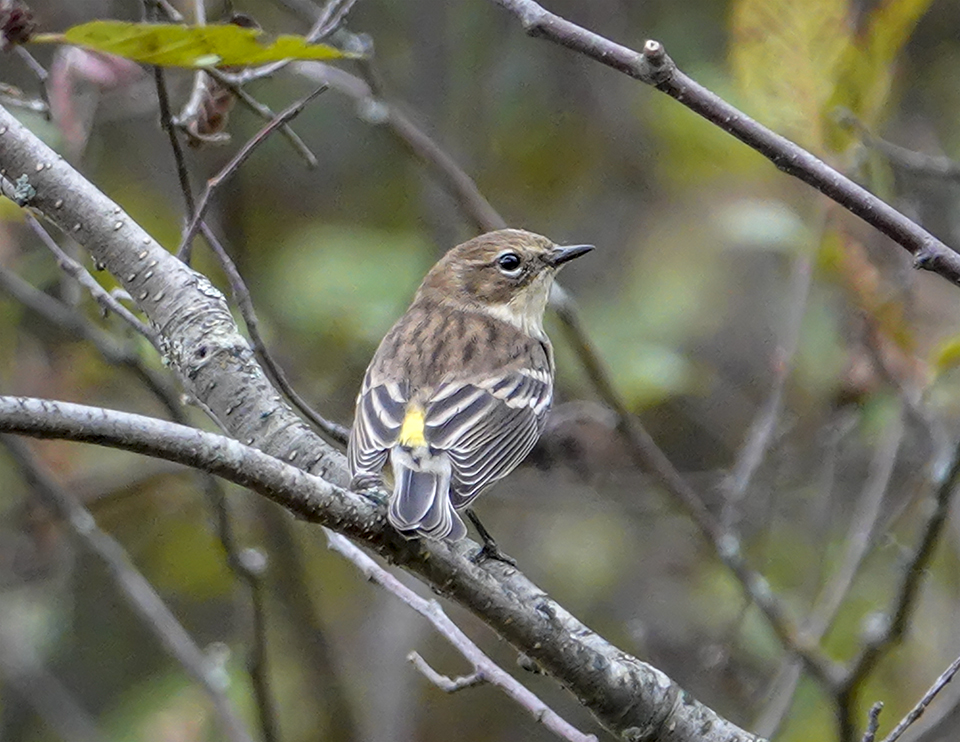
Like many warblers, Yellow-rumped Warblers on their breeding grounds are territorial. Males form territories shortly after arrival on their breeding grounds, by singing, displaying their plumage, and chasing other males.
During breeding season, Yellow-rump Warblers interact only with their mates until after their young are cared for. At that time, they may join single- or mixed-species flocks.
When foraging with other warbler species, Yellow-rumped Warblers generally are subordinate to Palm Warblers, Magnolia Warblers, and Black-throated Green Warblers. However, they are said to be socially dominant over Pine Warblers and Northern Parulas. Sources conflict on the relationship between Yellow-rumped Warblers and Blackburnian Warblers.
Yellow-rumped Warbler: Migration
Yellow-rumped Warblers are short to long-distance migrants. Most Eastern Yellow-rumped Warblers winter in the US, along the Gulf Coast and Atlantic Coast north to Massachusetts. Some Yellow-rumps spend the winter in southeastern New York, Pennsylvania, Ohio, Indiana, Kansas, and Illinois. Others winter south of the US in Mexico, Bermuda, and the Caribbean region.
Yellow-rumped Warblers are among the first warblers to return to their breeding grounds in the spring, with the spring migration occurring over a relatively short period of time. The northbound spring migration for Yellow-rumped Warblers begins in late March through early May, with the first migrants arriving on their breeding grounds as early as late March. Most will have returned by late April. Yellow-rumped Warblers are generally the last warblers to leave in the fall. The southbound fall migration begins in late August and extends through the end of November.
Migration patterns affecting the Yellow-rumped Warblers we see here in the Adirondack Mountains reflect these trends.
- In the Adirondack Park, the pattern of eBird sightings from the six core Adirondack Park counties indicate that Yellow-rumped Warblers begin arriving in early April. The number of eBird sightings peaks starting in early May. Some of the birds seen in our area in early spring will probably continue north to breed in Canada, while some will remain to breed in our region.
- Yellow-rumped Warblers apparently begin leaving their breeding grounds in the Adirondacks in mid-October. Estimating the departure time is difficult, because of the problem of disentangling reports which reflect birds which breed in the Adirondacks and those reflecting birds which are migrating through the area from Canada. In any event, it appears that most Yellow-rumped Warblers who breed in the Adirondacks will have left by mid-November, with a few stragglers seen in December and January.
Like many other warblers, Yellow-rumped Warblers are usually nocturnal migrants. Males tend to migrate before females. Yellow-rumps use a variety of habitats during migration, but are less common in forest interiors.
Yellow-rumped Warbler: Diet and Foraging
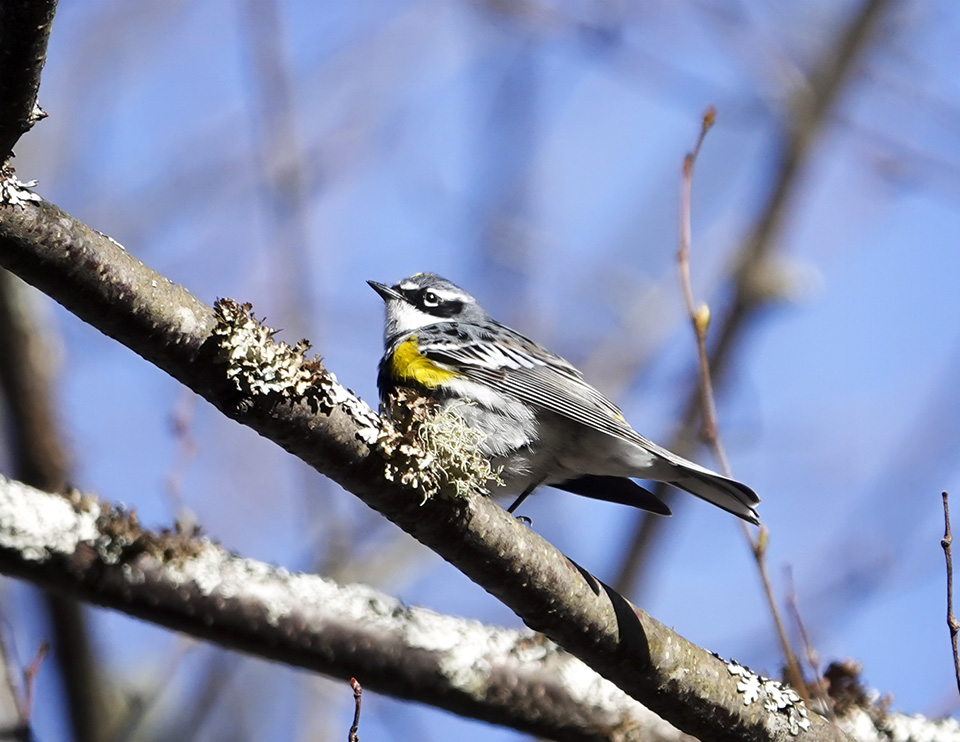
As with other New World Warblers, Yellow-rumped Warblers feed primarily on insects on their breeding grounds. Their summer menus include caterpillars and other larvae, leaf beetles, bark beetles, weevils, ants, scale insects, aphids, grasshoppers, caddisflies, craneflies, gnats, and spiders. Yellow-rumps also consume spruce budworm during outbreaks.
During migration and on their wintering grounds, these birds eat fruits, particularly bayberry and wax myrtle. Their ability to digest the latter items allows them to winter much farther north than other warbler species.
Yellow-rumped Warblers in the Adirondacks and other eastern regions forage primarily in conifers. They are said to be generalist foragers. They use a wide variety of foraging methods, including gleaning, hovering, and fly catching. They are also quite versatile, in that they may use all parts of the trees. However, they often concentrate their efforts in the lower parts of trees, in contrast to Cape May Warblers (who tend to forage near the tops of spruce and fir trees, focusing on the outer branches) and Blackburnian Warblers (who forage mainly in the high and middle ranges).
Like several other warbler species (including Magnolia Warblers and Blackburnian Warblers), male Yellow-rumped Warblers tend to forage at higher average heights than females. Male Yellow-rumped Warblers appear to spend more time hovering than their female counterparts.
Yellow-rumped Warbler: Breeding and Family Life
The breeding cycle for Yellow-rumped Warblers begins soon after the birds arrive on their breeding grounds. Like many other species, the males arrive on the breeding grounds before the females. In New York State, Yellow-rumped Warblers breed mainly in June and July and are said to have only one brood.
Pairs form after the females arrive on their breeding grounds, usually several days to a week later. During courtship, male Yellow-rumped Warblers fluff out their side feathers, raise their wings and erect the feathers on their crowns to show off their black and yellow markings.
Nest building (usually by the female alone) takes about ten days. The nest is a cup of twigs, pine needles, grasses, rootlets, and moss, lined with fine hair and feathers. It is usually placed in a conifer. Favored tree species include Eastern Hemlock, Red Spruce and other spruces, Balsam Fir, Eastern White Pine and other pine species, Northern White Cedar, and Tamarack.
The female lays four or five eggs and incubates them for 12-13 days. Both parents feed the nestlings until their departure from the nest 10 to 14 days after hatching. Fledglings reportedly can make short flights two or three days after leaving the nest. The fledglings are usually fed mostly by the male.
Distribution of the Yellow-rumped Warbler:
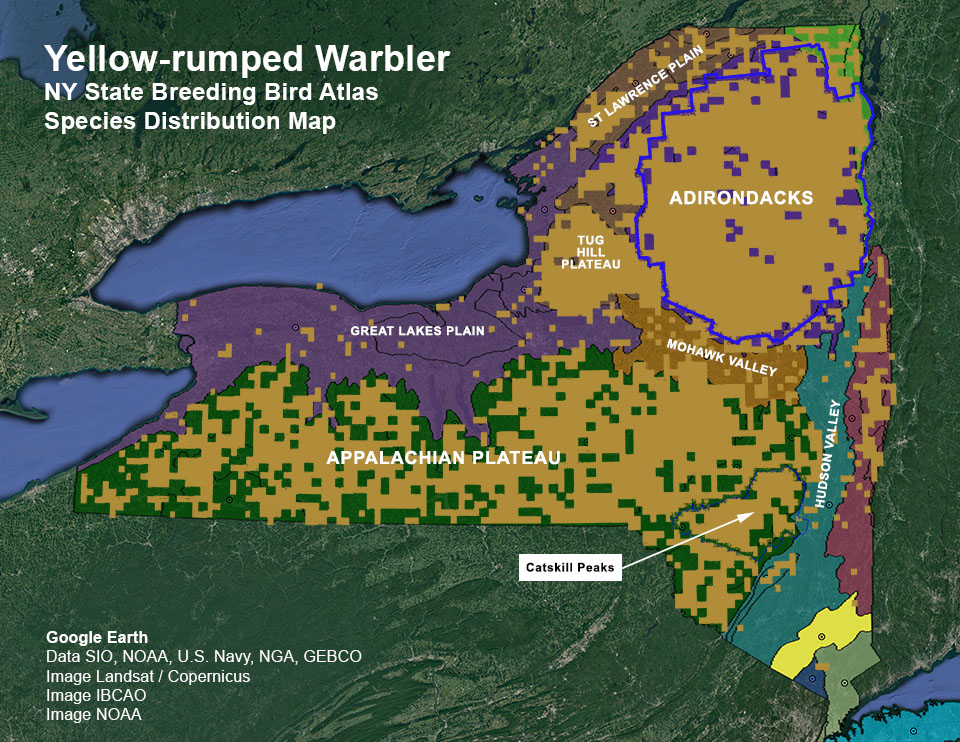
The Yellow-rumped Warbler has a broad breeding range. It breeds in conifer forests in the northern and northeastern parts of North America, stretching from Alaska through northern Quebec and Newfoundland south to northeast Minnesota, northern Wisconsin, northern Pennsylvania, southern New England, and southeastern New York State.
In New York State, Yellow-rumped Warblers breed mainly in the Adirondacks, Tug Hill area, Catskill Peaks, and Appalachian Plateau. This species is a common summer resident throughout the Adirondacks.
- In the 1980-1985 New York State Breeding Bird survey, breeding Yellow-rumped Warblers were concentrated in the central Adirondacks, High Peaks, western Adirondack foothills, and Tug Hill, with other confirmed breeding sites in the Appalachian Plateau, Champlain Valley, and Catskills.
- The 2000-2005 New York State Breeding Bird Survey found a 35% increase in the number of blocks with breeding Yellow-rumped Warblers. Breeding activity was found throughout the Adirondacks, plus much of the Appalachian Plateau and the Champlain Valley.
- Preliminary findings from the third New York Breeding Bird Atlas, which began on 1 January 2020 and covers 2020-2024, are consistent with this pattern. Most of the confirmed breeding sites are in the Adirondacks, with a few others scattered in the Appalachian Plateau.
The Yellow-rumped Warbler is of low conservation concern. According to Partners in Flight, the population is stable, with an overall population in North America is about 170 million breeding adults. The population estimate for New York State was in 2010 was 410,000. The 2000 Partners in Flight Bird Conservation Plan for the Adirondack Mountains indicated that the population of the Yellow-rumped Warbler in the Adirondack Park had been increasing since 1980.
Causes of mortality for individual Yellow-rumped Warblers are unclear. The oldest Yellow-rumped Warbler on record is a male aged 8 years and 9 months; he was trapped and released during banding operations. The average life span is probably much shorter. Some nestlings may die of exposure or starvation during cold, rainy periods. Another major cause of Yellow-rumped Warbler mortality is predation. Potential predators include American Kestrels, shrikes, Blue Jays, and gulls. Nest predators include Red Squirrels and American Crows.
Yellow-rumped Warbler: Breeding Habitat
Throughout their breeding range, Yellow-rumped Warblers breed mainly in conifer and mixed forests. Although this warbler apparently prefers mature conifer forests, generally dominated by spruce, pine, or cedar, some consider the Yellow-rumped Warbler to be a habitat generalist. Breeding pairs of Yellow-rumps have been found in mixed forests, deciduous forests with scattered conifers, and recently-logged forests where some mature trees have been left standing.
In New York State, breeding Yellow-rumped Warblers are most often found in conifer forests, particularly Mountain Spruce-Fir Forest, Alpine Krummholz, and alpine summits. However, they will also breed on the edges of young conifer forests and in mixed woods.
Where to find Yellow-rumped Warblers in the Adirondacks
Adirondack Birding Sites for Yellow-rumped Warblers
- West-Central Region
- Moose River Plains
- Third Lake Creek
- South Inlet
- Ferd's Bog
- Wheeler Pond Loop
- Stillwater Reservoir
- Beaver Lake
- Francis Lake
- High Peaks
- Lyon Mountain
- Northern Region
- Five Ponds Wilderness
Source: John M.C. Peterson and Gary N. Lee. Adirondack Birding. 60 Great Places to Find Birds (Lost Pond Press, 2008).
Adirondack birders in search of Yellow-rumped Warblers have a variety of birding sites to choose from, particularly in the west-central region of the Adirondack Park, as listed in Peterson and Lee's Adirondack Birding guide. Their list of birding sites for Yellow-rumped Warblers includes the Moose River Plains; Ferd's Bog, and the Wheeler Pond Loop in Hamilton County; Stillwater Reservoir in Herkimer County, and Lyon Mountain in Clinton County.
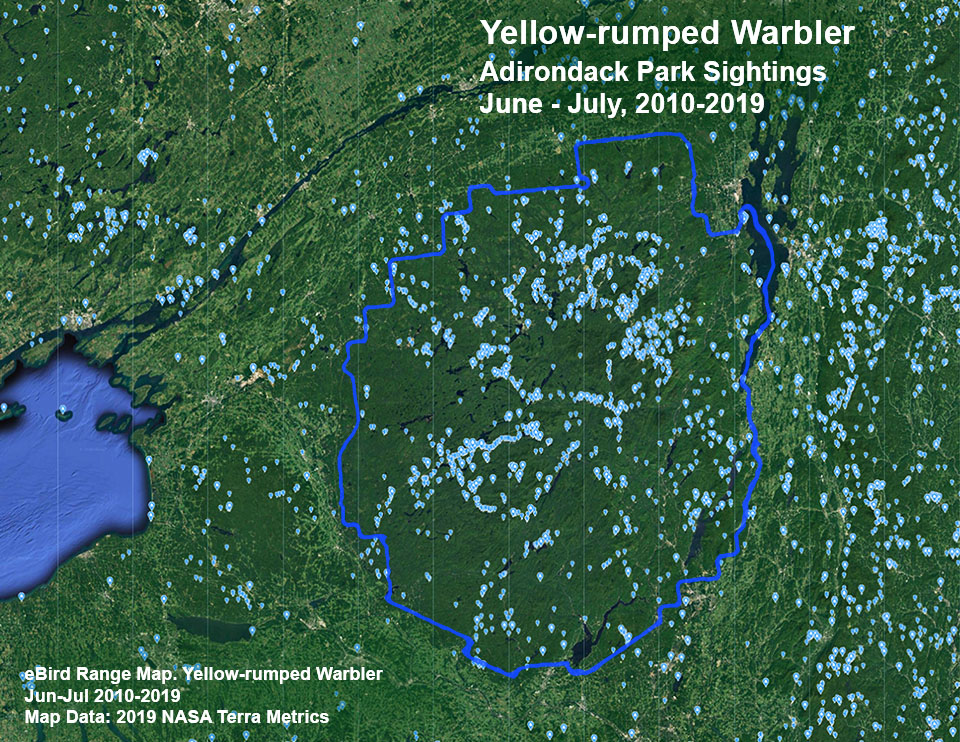
The pattern of eBird sightings for the Yellow-rumped Warbler during breeding season is roughly consistent with the Peterson/Lee recommendations and the findings of the three New York State Breeding Bird Surveys. Within the Adirondack Park, the list of eBird reports for the Yellow-rumped Warbler includes clusters of sightings in popular birding sites, such as the Paul Smith's College VIC, Bloomingdale Bog (North and South Entrances), Blue Mountain Road, and Madawaska Pond in Franklin County; Sabattis Road, Sabattis Bog, Northville-Placid Trail (Long Lake South), Ferds Bog, Blue Mountain Trail, and Moose River Plains in Hamilton County; Cranberry Lake Biological Station and Massawepie Mire in St. Lawrence County; Roosevelt Truck Trail (South), the Adirondack Interpretive Center, and Whiteface Mountain Memorial Highway in Essex County; Silver Lake Bog Preserve in Clinton County; and Amy's Park in Warren County.
Among the trails covered here, the most likely locations to look for Yellow-rumped Warblers include John Brown Farm, any of the trails at the Paul Smith's College VIC that go through conifer or mixed forest, as well as the Jackrabbit Trail at River Road, Hulls Falls Road, Lake Colby Railroad Tracks, and the Bloomingdale Bog Trail.
References
American Ornithological Society. Checklist of North American Birds. Setophaga coronata. Retrieved 15 March 2020.
Avibase. The World Bird Database. Yellow-rumped Warbler. Setophaga coronata. Retrieved 15 March 2020.
Integrated Taxonomic Information System. Setophaga coronata. Retrieved 17 March 2020.
Integrated Taxonomic Information System. Setophaga. Retrieved 23 March 2021
Cornell Lab of Ornithology, Ithaca, New York. All About Birds. Yellow-rumped Warbler. Setophaga coronata. Retrieved 15 March 2020.
Pamela D. Hunt and David J. Flaspohler. Yellow-rumped Warbler. Setophaga coronata. Version 1.0 in Birds of the World. (P. G. Rodewald, Editor). Cornell Lab of Ornithology, Ithaca, NY, USA. Subscription Web Site. Retrieved 15 March 2020.
Cornell Lab of Ornithology, Ithaca, New York. Macaulay Library. Yellow-rumped Warbler. Setophaga coronata. Retrieved 15 March 2020.
Cornell Lab of Ornithology, Ithaca, New York. eBird. An Online Database of Bird Distribution and Abundance. Bird Observations (Warren, Hamilton, Essex, Herkimer, Clinton, Franklin). Retrieved 15 March 2020.
Cornell Lab of Ornithology, Ithaca, New York. eBird. An Online Database of Bird Distribution and Abundance. Bird Observations (Hamilton). Retrieved 15 March 2020.
Cornell Lab of Ornithology, Ithaca, New York. eBird. An Online Database of Bird Distribution and Abundance. Bird Observations (Essex). Retrieved 15 March 2020.
Cornell Lab of Ornithology, Ithaca, New York. eBird. An Online Database of Bird Distribution and Abundance. Bird Observations (Hamilton, Essex). Retrieved 22 January 2020.
Kevin McGowan. Yellow-rumped Warbler. Cornell Lab of Ornithology, Ithaca, New York. Bird Academy. Be a Better Birder: Warbler Identification. Subscription Web Site. Retrieved 16 March 2020.
G.A. Gough, J.R. Sauer, and M. Iliff. Patuxent Bird Identification Infocenter. 1998. Version 97.1. Yellow-rumped warbler. Dendroica coronata. Patuxent Wildlife Research Center, Laurel, MD. Retrieved 16 March 2020.
USGS. Longevity Records of North American Birds. Myrtle Warbler. Retrieved 15 March 2020.
Boreal Songbird Initiative. Guide to Boreal Birds. Yellow-rumped Warbler. Dendroica coronata. Retrieved 15 March 2020.
Audubon. Guide to North American Birds. Yellow-rumped Warbler. Setophaga coronata. Retrieved 16 March 2020.
Bird Watcher's Digest. Bird Identification Guide. Yellow-rumped Warbler. Setophaga coronata. Retrieved 16 March 2020.
New York State. Department of Environmental Conservation. New York State 2000 - 2005 Breeding Bird Atlas: Species Distributions Map (Google Earth). Yellow-rumped Warbler. Retrieved 17 March 2020.
New York State. Department of Environmental Conservation. New York State Breeding Bird Atlas: Species Distribution Map, 1980-1985. Release 1.0. Updated 6 June 2007. Release 1.0. Updated 11 June 2011. Yellow-rumped Warbler. Retrieved 17 March 2020.
New York State. Department of Environmental Conservation. New York State Breeding Bird Atlas: Species Distribution Map, 2000-2005. Release 1.0. Updated 11 June 2011. Yellow-rumped Warbler. Retrieved 17 March 2020.
Keven J. McGowan, "Yellow-rumped Warbler," in Kevin J. McGowan and Kimberley Corwin (Eds). The Second Atlas of Breeding Birds in New York State (Cornell University Press, 2008), pp. 490-491.
John M.C. Peterson, "Yellow-rumped Warbler. Dendroica coronata," in Robert F. Andrle and Janet R. Carroll (Eds.) The Atlas of Breeding Birds in New York State (Cornell University Press, 1988). pp. 378-379.
New York Breeding Bird Atlas III. Breeding Guideline Bar Chart. Retrieved 29 January 2020.
New York Breeding Bird Atlas III. Breeding Season Table from Atlas 2000. Retrieved 29 January 2020.
New York Breeding Bird Atlas III. Hints on Haunts. Retrieved 29 January 2020.
New York Breeding Bird Atlas III. Species Map. Yellow-rumped Warbler. Setophaga coronata. Retrieved 2 April 2021.
Geoffrey Carleton. Birds of Essex County, New York. Third Edition (High Peaks Audubon Society, 1999), p. 35.
Charles W. Mitchell and William E. Krueger. Birds of Clinton County. Second Edition (High Peaks Audubon Society, 1997), p. 99.
Alan E. Bessette, William K. Chapman, Warren S. Greene and Douglas R. Pens. Birds of the Adirondacks. A Field Guide (North Country Books, Inc., 1993), p. 173, p. 33.
John M.C. Peterson and Gary N. Lee. Adirondack Birding. 60 Great Places to Find Birds (Lost Pond Press, 2008), pp. 88-90. 98-101, 105-107, 140-144, 150-154, 161-162, 166-168, 172-174, 178-182.
J. R. Sauer, D. K. Niven, J. E. Hines, D. J. Ziolkowski, Jr, K. L. Pardieck, J. E. Fallon, and W. A. Link. 2017. Trend Esimates for Core Survey Data. 1966 - 2017. Version 5.03.2019. USGS Patuxent Wildlife Research Center, Laurel, MD. Retrieved 27 January 2020.
Sauer, J. R., D. K. Niven, J. E. Hines, D. J. Ziolkowski, Jr, K. L. Pardieck, J. E. Fallon, and W. A. Link. 2017. The North American Breeding Bird Survey, Results and Analysis 1966 - 2015. Version 2.07.2017. USGS Patuxent Wildlife Research Center, Laurel, MD. Retrieved 17 March 2020.
Sauer, J. R., D. K. Niven, J. E. Hines, D. J. Ziolkowski, Jr, K. L. Pardieck, J. E. Fallon, and W. A. Link. 2017. The North American Breeding Bird Survey, Results and Analysis 1966 - 2015. Trend Estimate by Species. Yellow-rumped Warbler. Setophaga coronata. Version 2.07.2017. USGS Patuxent Wildlife Research Center, Laurel, MD. Retrieved 17 March 2020.
Vermont Atlas of Life. Vermont Breeding Bird Species Profiles. Yellow-rumped Warbler. Setophaga coronata. Retrieved 17 March 2020.
Mass Audubon. Breeding Bird Atlas 2. Species Accounts. Yellow-rumped Warbler. Dendroica coronata. Retrieved 17 March 2020.
Michigan Breeding Bird Atlas II. Species Accounts. Yellow-rumped Warbler. Dendroica coronata. Retrieved 23 August 2020.
Wisconsin Breeding Bird Atlas I. Species Maps. Yellow-rumped Warbler. Retrieved 23 August 2020.
Yellow-rumped Warbler. Setophaga coronata. Retrieved 23 August 2020.
Minnesota Breeding Bird Atlas. Setophaga coronata. Retrieved 22 March 2021.
Partners in Flight. 2020. Population Estimates Database, version 3.1. Retrieved 22 March 2021.
Partners in Flight. Partners in Flight Landbird Conservation Plan. 2016 Revision for Canada and Continental United States, pp. 111. Retrieved 23 November 2018.
Partners in Flight. Bird Conservation Plan for the Adirondack Mountains, pp. 9,37. Retrieved 23 November 2018.
Alexander C. Martin, Herbert S. Zim, and Arnold L. Nelson. American Wildlife & Plants. A Guide to Wildlife Food Habits (Dover Publications, 1951), pp. 163-164. Retrieved 22 March 2021.
Verne E. Davison. Attracting Birds from the Prairies to the Atlantic (Thomas Y. Crowell Company, 1967), pp. 141-142.
Richard M. DeGraaf. Trees, Shrubs, and Vines for Attracting Birds. Second Edition (University Press of New England, 2002), pp. 45-46, 48, Retrieved 28 February 2020.
Richard M. DeGraaf and Mariko Yamasaki. New England Wildlife: Habitat, Natural History, and Distribution (University Press of New England, 2001), pp. 224-225, 396-399, 423-426. Retrieved 22 March 2021.
New York State. Department of Environmental Conservation. New York Natural Heritage Program. Ecological Communities of New York State. Second Edition (March 2014), pp. 104-105, 123-124. Retrieved 17 October 2015.
New York Natural Heritage Program. 2021. Online Conservation Guide for Mountain Spruce-Fir Forest. Retrieved 22 March 2021.
New York Natural Heritage Program. 2021. Online Conservation Guide for Alpine Krummholz. Retrieved 22 March 2021.
Kimball L. Garrett and John D. Dunning, Jr., "Wood-Warblers ," in Christ Elphick, John B. Dunning, Jr., and David Allen Sibley (eds.), The Sibley Guide to Bird Life & Behavior (Alfred A. Knopf, 2001), pp. 492-509. Retrieved 22 March 2021.
Jonathan Alderfer, Ed. Complete Birds of North America(National Geographic, 2006), pp. 528-529. Retrieved 22 March 2021.
Donald and Lillian Stokes. Stokes Field Guide to Warblers (Little, Brown and Company, 2004), pp. 21-22, 33-39, 98-99, 158-159.
Tom Stephenson and Scott Whittle. The Warbler Guide (Princeton University Press, 2013), pp. 476-491, 548
Chris G. Earley. Warblers of the Great Lakes Region & Eastern North America (Firefly Books, 2003), pp. 50-53. Retrieved 22 March 2021.
Frank M. Chapman. The Warblers of North America. Third Edition (D. Appleton & Company, 1907), pp. 141-147. Retrieved 22 March 2021.
Jon Curson, David Quinn and David Beadle. Warblers of the Americas. An Identification Guide (Houghton Mifflin Company, 1994), pp. 123-125, Plate 7. Retrieved 22 March 2021.
Jon L. Dunn and Kimball L. Garrett. A Field Guide to Warblers of North America (Houghton Mifflin Company, 1997), pp. 267-282, Plate 12. Retrieved 22 March 2021.
Douglass H. Morse. American Warblers: An Ecological and Behavioral Perspective (Harvard University Press, 1989), pp. 60, 68-70, 174-178, 200-201. Retrieved 3 April 2021.
Arthur Bent. Life Histories of North American Wood Warblers. Part One and Part Two (Smithsonian Institution. United States National Museum. Bulletin 203, 1953), pp. 239-258. Retrieved 13 November 2018.
The Nature Conservancy. Terrestrial Habitats. New York State. Retrieved 29 January 2020.
The Nature Conservancy. Acadian-Appalachian Montane Spruce-Fir-Hardwood Forest. Retrieved 22 March 2021.
The Nature Conservancy. Acadian-Appalachian Alpine Tundra. Retrieved 22 March 2021.
iNaturalist. Adirondack Park Sightings. Yellow-rumped Warbler. Retrieved 22 March 2021.
iNaturalist. Yellow-rumped Warbler. Setophaga coronata. Retrieved 22 March 2021.
Aretas A. Saunders. The Summer Birds of the Northern Adirondack Mountains. Roosevelt Wild Life Bulletin. Volume 5. Number 3 (September 1929), pp. 326-499. Retrieved 2 March 2017.
Theodore Roosevelt, "The Summer Birds of the Adirondacks in Franklin County, N.Y.," Roosevelt Wild Life Bulletin, Volume 5. Number 3 (September 1929), pp. 501-504. Retrieved 2 March 2017.
Perley M. Silloway, "Relation of Summer Birds to the Western Adirondack Forest," Roosevelt Wild Life Bulletin, Volume 1, Number 4 (March 1923), pp. 396-486. Retrieved 2 March 2017.
Elon Howard Eaton. Birds of New York (New York State Museum, 1914), pp. 406-408. Retrieved 12 November 2018.
C. Hart Merriam, "Preliminary List of Birds Ascertained to Occur in the Adirondack Region. Northeastern New York," Bulletin of the Nuttall Ornithological Club, Volume 6, Number 4 (October 1881), pp. 225-235. Retrieved 10 December 2018.
George K. Peck and Ross D. James. Breeding Birds of Ontario: Nidiology and Distribution. Volume 2: Passerines (Royal Ontario Museum, 1987), pp. 150-151. Retrieved 1 April 2021.
James A. Jobling. Helm Dictionary of Scientific Bird Names (Christopher Helm, 2010), p. 118. Retrieved 9 January 2019.
Floyd E. Hayes, "Definitions for Migrant Birds: What Is a Neotropical Migrant?" The Auk, Volume 112, Number 2 (April 1995), pp. 521-523. Retrieved 19 January 2020.
Douglass H. Morse, “Variables Affecting the Density and Territory Size of Breeding Spruce-Woods Warblers,” Ecology, Volume 57, Number. 2 (March 1976), pp. 290-301. Retrieved 25 March 2021.
Douglass H. Morse, “The Foraging of Warblers Isolated on Small Island,” Ecology, Volume 52, Number 2 (March 1971), pp. 216-228. Retrieved 25 March 2021.
Robert H. MacArthur, "Population Ecology of Some Warblers of Northeastern Coniferous Forests,” Ecology, Volume 39, Number 4 (October 1958), pp. 599-619. Retrieved 4 February 2020.
